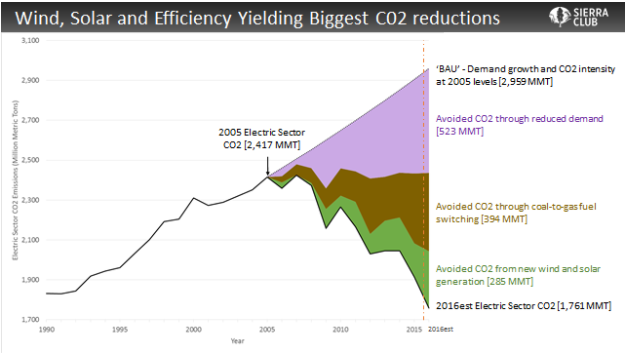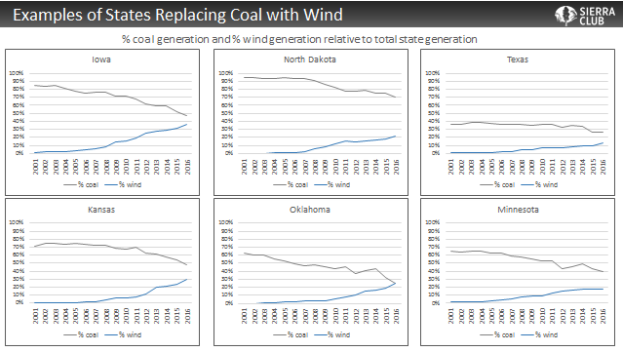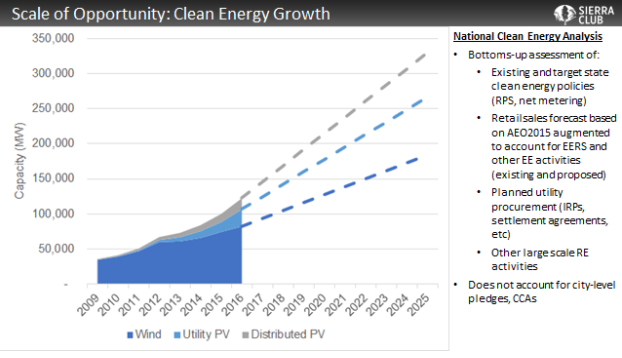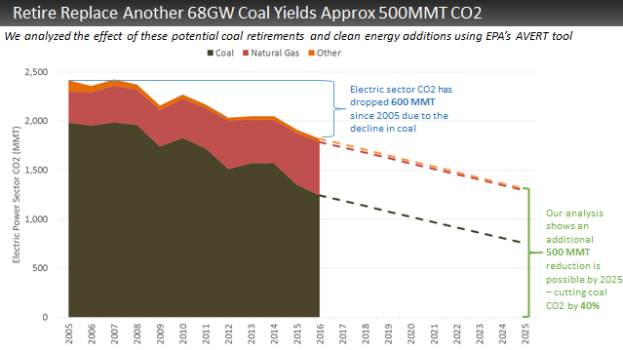Regardless of who is in the White House, a new Sierra Club analysis has found dramatic reductions in carbon pollution from the U.S. electric sector are moving full speed ahead and will continue to grow, putting U.S. Paris climate targets within reach despite Trump’s intentions to exit the Paris Agreement.
The analysis shows that ongoing advocacy to replace coal ― and increasingly fracked gas ― with clean energy can slash U.S. electricity sector carbon pollution by at least another half billion tons annually between 2017 and 2025, the deadline for the U.S. to hit its 2025 Paris commitment. In spite of Trump’s directive to repeal the Clean Power Plan and the absence of any national carbon reduction strategy, the U.S. is already approximately halfway to meeting its 2025 carbon reduction commitment under the Paris Agreement. The majority of these reductions between 2005 and 2016 ― 600 million metric tons (MMT) ― have come from the electric sector, where we have led the world in retiring and replacing coal-fired power plants with clean energy and reduced electricity demand. Our updated analysis concludes that the U.S. can almost double those carbon reductions from the electric sector by another 500 MMT, as the 61 coal plants that have already announced retirement begin to come offline and as the Sierra Club’s Beyond Coal Campaign continues its successful advocacy to replace another 77 coal plants with clean energy by no later than 2025.
The analysis also reveals that the U.S. can cut carbon pollution faster than was projected even six months ago. In March 2017, the Sierra Club released a report indicating that between 2016 and 2025, the U.S. could cut electric sector emissions by 478 MMT. We now have 2016 emission data showing that the U.S. cut carbon pollution faster than initially projected, with emissions dropping nearly 100 MMT in just 2016 alone. The bulk of these reductions have occurred as we have replaced coal with clean energy and energy savings.

In addition, the decreasing cost of clean energy has expanded the number of opportunities for organizations like the Sierra Club to join forces with industrial, commercial, and low-income ratepayer advocates to argue for replacing coal with clean energy in every corner of the U.S.
The new analysis flows from our collective success over the past seven years working to replace coal and fracked gas with clean energy. Since 2010, our advocacy, in partnership with allied organizations, has helped secure the retirement of 71 gigawatts (GW) of existing coal-fired power plants and another 41 GW of coal plants announced to retire no later than 2025. This represents 34 percent of the coal fleet that was operating in 2009 and a huge step toward ensuring we are on track to retire all coal plants within the next 10-15 years.
Later this fall, we will be marking the halfway point ― when the U.S. officially hits 262 coal plants retired or announced to retire ― out of 523 coal plants that were operating in 2009. Currently, 257 coal plants have retired or are announced to retire, and this comes as clean energy is growing faster than ever and replacing coal across the country in state after state.

Our new analysis has been informed by our intimate knowledge of each of the remaining 278 coal plants and their economic, environmental, and societal liabilities. As recounted in Politico’s in-depth story on Sierra Club’s Beyond Coal Campaign,with over 100 allied organizations, we are waging a grassroots campaign that is focused on replacing coal with clean energy with a laser focus on the health effects of pollution from coal plants and the high economic cost of coal. We are continuing to file legal challenges to coal plants and projects, and against coal’s defenders Scott Pruitt and Donald Trump, at the rate of one every three days (including holidays and weekends). We are also engaged in venues nationwide to accelerate the rise of clean energy and ensure fossil fuel companies don’t succeed in their efforts to undermine the growth of renewables.
This effort includes engaging in dozens of Public Utility Commission proceedings at any given moment, where we are arguing that continuing to operate existing coal plants is more expensive than new investments in wind and solar. For example, we assessed that 40 percent of Warren Buffett’s Pacificorp Fleet is losing money and also examined how San Antonio is poised to spend $100 million more on its coal plant than it would if it retired and replaced the coal plant with clean energy.
In our new analysis, we used EPA’s AVoided Emissions and geneRation Tool (AVERT). For inputs, we used 1) the 41 GW of coal announced to retire by 2025, but that are still operating, 2) 77 plants totaling 67 GW that we are targeting for retirement before 2025, based on environmental and economic liabilities, and 3) a tripling of clean energy installations based on a Sierra Club National Clean Energy Assessment (NCEA). This NCEA is a bottom-up, state-by-state model we have constructed that assesses the amount of clean energy that could be deployed by 2025 through strategic advocacy opportunities. This includes opportunities to expand renewable energy standards as well as regulatory and nonregulatory venues, such as integrated resource planning proceedings, where we can advocate for additional clean energy investments. The chart below shows our projected growth in wind and solar, both distributed and utility scale.
In sum, between 2017 and 2025 we see the opportunity to increase the deployment of wind and solar threefold from present levels.

With these inputs, the AVERT model concluded we can reduce U.S. electric sector emissions by at least 500 MMT. The bulk of these reductions were from coal, but the reductions from fracked gas are starting to increase as we turn our attention to replacing fracked gas with clean energy in coal-free states, such as along the West Coast and the northeastern states.
We are confident that we can continue reducing U.S. coal use and slashing carbon pollution at this pace despite the Trump Administration and its pro-coal efforts. In fact, since January 2017, the Sierra Club has already secured the retirement of an additional 10 coal plants, totaling 5.6 GW, including the largest coal plant ever to retire in the U.S. -- the massive Stuart plant in Ohio. In that same time period, the two largest clean energy investments in U.S. history were announced by Xcel Energy and AEP. Given that most decisions impacting coal plants and clean energy development occur at the local and state level, we remain optimistic that we can and will continue to make enormous progress that cannot be reversed by the new regime in Washington.

The work ahead of us will not be easy. The Trump Administration is creating challenges at every turn, but we have prevailed under adversarial administrations in the past and are already securing major coal retirements and renewable energy expansion in Trump’s first year in office.
While Trump may be attempting to withdraw the U.S. from the Paris Agreement, the Sierra Club’s advocacy is helping the U.S. move closer to meeting the Agreement’s carbon reduction goals regardless -- and we’re in it for the long haul, in the streets, in the courtrooms, and in a Public Utility Commission hearing near you. Now, it’s back to work.
